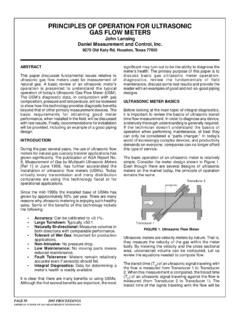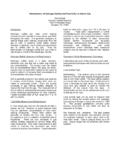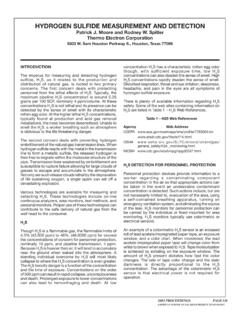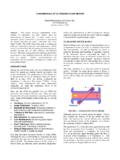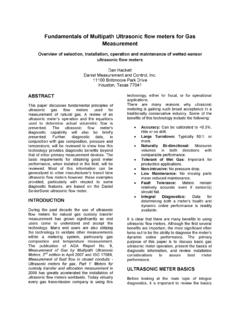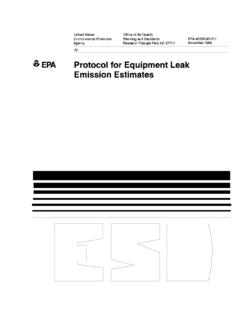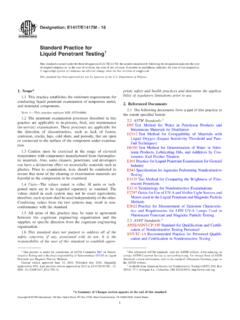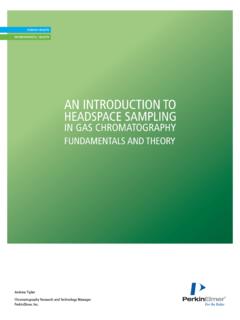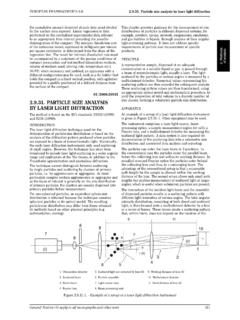Transcription of Fundamentals of NGL Sampling Systems - ASGMT
1 Fundamentals of NGL Sampling Systems By Dominic Giametta & Jim Klentzman The purpose of this paper is to discuss in depth the Systems we use as a standard to sample natural gas liquids, or NGL s. Before we discuss the Systems and methods used to sample these products, we must first clearly define what NGL s are. NGL s can be a combination of any fluid in liquid form that is taken from the pipeline under pressure. Typically, NGL refers mainly to ethane, propane, butanes, and natural gasolines (pentanes) & condensates. Because of the broad range of products that can be claimed as NGL s, there are many different approaches to the methods by which we sample them. The common thread among all NGL s is that these products; in order to be maintained and properly sampled, require the use of specific Sampling techniques unique to light liquid and NGL Sampling . To further expand on the Sampling techniques used in NGL and light liquid Sampling , we must first have a look at the current need for Sampling system in the NGL market and discuss why there is such a need for these Systems .
2 NGL s are a production by product of the shale gas boom that is occurring across our country. Over the past few years the new developments in fracking techniques, has allowed many production companies to drill gas wells and produce large amounts of natural gas that traditionally was not available to us through other conventional methods. This large spike in natural gas surplus subsequently has driven the price of natural gas down, and caused some alarm amongst the production companies in the US market. During the last five years, a shift in the production methods and refinement process of natural gas has caused many of these producers to look at the benefit of drilling liquid rich shale formations. These liquid rich shale plays are notorious for producing higher amounts of NGL s. With these NGL s being more profitable than the falling natural gas prices, the push towards separating and selling these NGL s has meant a tremendous increase in those companies profitability.
3 Naturally, this increase in profitability has prompted the age old question of how much do we have, and what exactly do we have . This is where the importance of proper Sampling and collection techniques becomes vital and necessary. Implementation of proper Sampling techniques is important in many areas of the oil and gas process. Delivery of oil and gas and the byproducts of those components to the marketplace prompt us to require Sampling at many different stages of the process. For instance, liquid petroleum gas, commonly known as LPG s are the most pure forms of NGL s found in the market place. The refinement process of these components can be accomplished in several different ways. During the refinement process, these LPG s are separated out so that they can be stored in individual storage tanks or sent down a pipeline to another customer or facility. The separation process of these types of products is accomplished by several different methods within the processing plants.
4 In the good old days lean oil plant NGL recoveries we see a limitation of the amount of LPG s that are recovered from the gas streams. This number is increased in cryogenic plants where propane is used to pre-chill the gas. The most effective extraction of LPG s in a processing plant application is by means of cryogenic technology. This method, it should also be noted, is the most costly to build. This method encompasses compressing the components and then sending them through an apparatus known as a turbo expander. This device uses a controlled drop in pressure to chill the products therefore causing the heavier components of the gas to fall out of the gas stream in a liquid form. However effective these methods are it remains in some processing plants, only methane is separated out of the group of components. The remaining mixture of components (ethane through pentanes) is left in the liquid stream and is often referred to as Y-grade . Another area where LPG production is found is in crude oil refineries.
5 LPG s are produced by fractionation of the crude oils into lighter hydrocarbons by a multitude of processes. The relationship Sampling holds in these applications is important to realize and can greatly affect the profitability factor of each company involved. In LPG refinement applications, the Sampling process is used to determine the liquid hydrocarbon content simply because there is no water due to the intensity of the process. By Sampling in these applications, we can determine the molecular percentage of the products, therefore realizing its market value. Another application where we would see NGL Sampling needs is in the separation of the gas stream in the production field or upstream of the gas processing plants. These separators are designed to drop out the liquid components of the gas stream by using gravity and kinetic energy of the flowing stream against the side of the vessel. The different components experience a level of separation where gas, liquid hydrocarbons and water will exist on different levels.
6 Utilizing a series of valves and level detecting devices, these tanks will be emptied of the water and hydrocarbons. The water will be sent into one stream for disposal and the liquid hydrocarbons into another stream to be measured and then sent on to reach its intended use. This method, although inexact, is very useful and mostly cost effective in being able to separate the components coming in from the production well. In most cases during the operation of the separator dumping process, there often times can be water carryover experienced into the liquid hydrocarbon stream. This is most often experienced when the dumping of the much heavier NGL s, such as condensate, occurs within the separator. In this case we look to a tool used in measurement that will enable us to check the content of the liquid hydrocarbon stream as it leaves the separator. Water content is a critical part of determining the value of these hydrocarbons during custody transfer.
7 As in many crude oil applications, line conditioning when Sampling these types of light liquids must be considered. A very useful method for preconditioning of the line is by introducing a static mixer into the stream prior to the Sampling apparatus. The static mixer uses a series of blades engineered to create a homogenous mixture of the water and hydrocarbons. The mixer uses the flowing velocities of the stream to create turbulence. The resulting mixture is a representation of the entire flowing stream. An important factor that must be considered when using a static mixer is that the mixer must have adequate flow at the sample point to create the homogenous flow scenario. A second factor that greatly influences the resulting sample is the placement of the sample in the pipe run. The sampler must be placed in an area where the flow is adequate, but also there must be consideration as to whether or not there is inherent water traps located in the pipe run.
8 If the sampler is located improperly near one of these trap areas, it could be detrimental to the results given by the sampler. Placing the sampler on a vertical run of pipe after the separator is an example of a good place where water traps will not be experienced. It should also be noted that the placement of the mixer in conjunction with the Sampling pump is very important in the mixing process. This is mostly due to the rapid settling out of the water in these types of liquid hydrocarbons, and is important when Sampling for water cut applications. It is important to note also that the sampler should be used in conjunction with a second measurement device such as a turbine, or ultrasonic meter. This will allow the operator to take sample grabs that will be proportional to the flow of product through the pipeline at any given time. Combining these two measurement tools allows us to firstly measure how much product is flowing in the pipeline as well as defining what content we have in the pipeline.
9 This is the most accurate way to ensure that the sample is most representative of the composition of the flowing stream, and is the recommended practice for most applications. Is it by using this method we can properly allocate back to where the products are being delivered from; ultimately having a tremendous monetary impact for the producer, customers, and land owners. The first aspect of the system to discuss is in order for the Sampling of light liquid hydrocarbons to be representative of what is in the pipeline we must ensure that the pressure in the pipeline or vessel is maintained at the condition that it exists while it is being sampled. There should be no reduction of pressure or the phase of the liquid could flash or change into a gaseous state. The best way to accomplish this is by using a dual cavity or constant pressure cylinder. This cylinder involves an internal piston which can be reciprocated with pressure by manipulation of valves on each end cap of the cylinder.
10 The end caps are held by either tie rods or threads that secure the end caps. There are many features of these types of cylinders that promote both accuracy and safety all the while ensuring properly collecting an NGL sample. One of these features is an external indicator to show the location of the piston in the cylinder. The indicator can be a magnet style tracking device or a rod connected to the piston. This is important to know the fill level of the cylinder to allow for any expansion that could occur within the cylinder. Because these cylinders have the capacity to hold a constant pressure, the likelihood of expansion in minimized, but the fill indicator gives the technician a method of reassuring that the capacity of the cylinder remains at a constant level, and the sample has not phased changed any. These cylinders also incorporate burst disc reliefs and optional relief valves to help support the safety functions of the cylinder.
